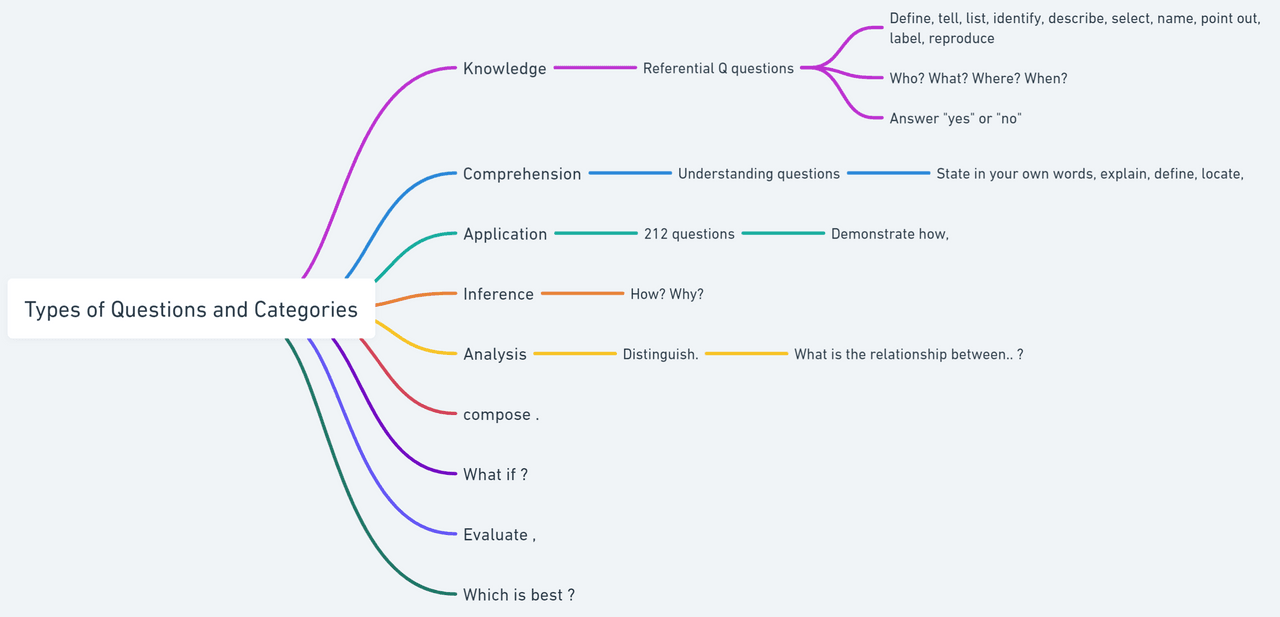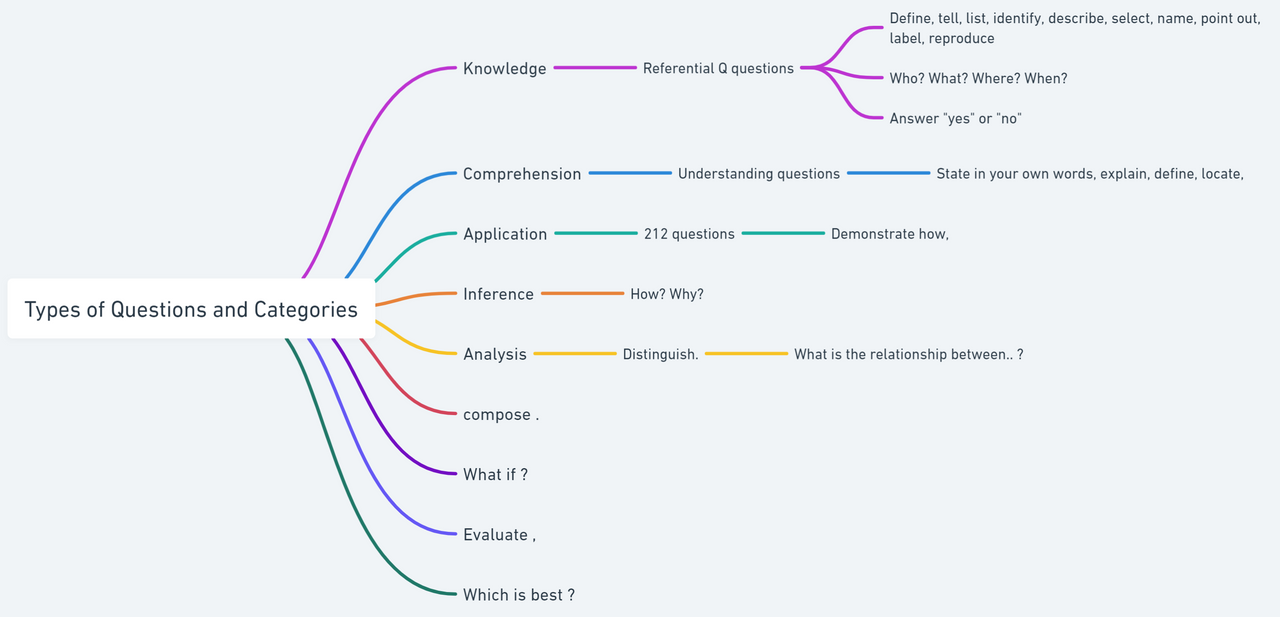
질문의 종류

질문의 종류와 범주


1. Knowledge
질문의 범주
referential Q questions
질문의 내용 및 질문에 사용되는 전형적인 단어들
Define, tell, list, identify, describe, select, name, point out, label, reproduce. Who? What? Where? When? Answer "yes" or "no"
2. Comprehension
질문의 범주
이해 questions
질문의 내용 및 질문에 사용되는 전형적인 단어들
State in your own words, explain, define, locate, select, indicate, summarize, outline, match
3. Application
질문의 범주
212 questions
질문의 내용 및 질문에 사용되는 전형적인 단어들
Demonstrate how, use the data to solve, illustrate how, show how, apply, construct, explain. What is used for? What would result? What would happen?
4. Inference
질문의 내용 및 질문에 사용되는 전형적인 단어들
How? Why? What did~mean by? What does believe? What conclusion can you draw from...?
5. Analysis
질문의 범주
분석 questions
질문의 내용 및 질문에 사용되는 전형적인 단어들
Distinguish, diagram, chart, plan, arrange, separate, outline, classify, contrast, compare, differentiate, categorize. What is the relationship between? What is the function of? What motive? What conclusions? What is the main idea?
6. Synthesis
질문의 범주
종합 questions
질문의 내용 및 질문에 사용되는 전형적인 단어들
Compose, combine, estimate, invent, choose, hypothesize, build, solve, design, develop. What if? How would you test? What would you have done in this situation? What would happen if...? How can you improve...? How else would you...?
7. Evaluation
질문의 범주
평가 questions
질문의 내용 및 질문에 사용되는 전형적인 단어들
Evaluate, rate, defend, dispute, decide which, select, judge, grade, verify, choose why. Which is best? Which is more important? Which do you think is more appropriate?
Bloom's Taxonomy of Cognitive Learning Objectives
1. Remembering
Description: Recall or recognize terms, definitions, facts, ideas, materials, patterns, sequences, methods, principles, etc.
Sample Questions:
What is...?
How would you define...?
Can you select...?
2. Understanding
Description: Understand the meaning, translation, interpolation, and interpretation of instructions and problems. State a problem in one's own words.
Sample Questions:
How would you classify...?
Can you explain what is happening...?
What do you think causes...?
3. Applying
Description: Use a concept in a new situation or unprompted use of an abstraction. Applies what was learned in the classroom into novel situations in the workplace.
Sample Questions:
How would you use...?
What examples can you find to...?
How would you solve... using what you have learned?
4. Analyzing
Description: Separates material or concepts into component parts so that its organizational structure may be understood. Distinguishes between facts and inferences.
Sample Questions:
What are the parts or features of...?
How is... related to...?
Why do you think...?
5. Evaluating
Description: Make judgments about the value of ideas or materials.
Sample Questions:
What is your opinion of...?
How would you prove...?
Can you assess the value or importance of...?
6. Creating
Description: Builds a structure or pattern from diverse elements. Put parts together to form a whole, with emphasis on creating a new meaning or structure.
Sample Questions:
What would you predict/infer from...?
What ideas can you add to...?
How would you create/design a new...?
This taxonomy provides a useful framework for educators to create a diverse range of questions that test different cognitive skills, from basic recall to higher-order thinking.
`
SOLO Taxonomy
SOLO Taxonomy (Structure of Observed Learning Outcomes). Developed by Biggs and Collis in 1982, the SOLO taxonomy classifies learners' understanding into five levels of complexity:
1. Pre-structural
Description: At this level, the student is simply acquiring bits of unconnected information, which have no organization and make no sense.
Sample Questions:
What do you know about...?
Can you list...?
2. Uni-structural
Description: At the uni-structural level, the student's understanding is limited to one aspect of the task. They can identify, name, or point to this single aspect.
Sample Questions:
What is...?
Define...?
Identify...?
3. Multi-structural
Description: The student knows several aspects but sees them as independent or isolated. They can enumerate or describe, taking a list-like approach.
Sample Questions:
Describe the process of...?
List the factors of...?
What are the main ideas of...?
4. Relational
Description: The different aspects have become integrated into a coherent whole. The student can relate parts to the whole and understand the significance or underlying purpose.
Sample Questions:
How does ... relate to ...?
What causes...?
Explain why...?
5. Extended Abstract
Description: At this highest level, the student can generalize the structure they have learned to a new domain. They can theorize or hypothesize beyond what's given.
Sample Questions:
How would you apply what you learned to develop...?
Predict how ... will change in the future.
How would you generalize the rule of...?
The SOLO taxonomy is particularly useful in educational settings as it helps educators gauge the depth of understanding and cognitive abilities of their students.
Question-Answer Relationship (QAR)
Question-Answer Relationship (QAR) strategy. This strategy helps students understand different types of questions. By categorizing questions, students can better understand how to find or formulate answers.
1. Right There (Literal)
Description: The answer is directly stated in the text. It's typically a fact or detail that can be pointed to.
Sample Questions:
Who is the main character?
What happened after...?
Where did the event take place?
2. Think and Search (Search and Find Out)
Description: The answer is in the text, but it requires the student to "put together" different parts of the text to find the answer.
Sample Questions:
What were the reasons for...?
How did the character change from the beginning to the end of the story?
Summarize the main events in the story.
3. Author and You (Reading Between the Lines)
Description: The answer is not explicitly in the text. Students must use what they already know, along with what the author has provided, to infer an answer.
Sample Questions:
Why do you think the character did...?
How would you feel if...?
What might happen next?
4. On My Own (Beyond the Text)
Description: The answer does not rely on the text at all. Instead, it's based entirely on the student's own experiences and knowledge.
Sample Questions:
How does this relate to your life?
Have you ever had an experience like...?
What do you think about...?
The QAR strategy is often used in reading comprehension instruction to help students understand where and how to find answers to questions about a text. It encourages students to be more active and thoughtful readers.
Costa's Levels of Questioning
Costa's Levels of Questioning, which is based on Arthur Costa's model of intellectual functioning. This model is grounded in Bloom's Taxonomy but is more focused on the thinking processes.
1. Level One: Gathering
Description: These are basic recall questions. They require a basic understanding or memory of the topic.
Sample Questions:
Who...?
What...?
When...?
Where...?
2. Level Two: Processing
Description: These questions require the thinker to make sense of or process what they know. They often involve comparing, contrasting, and analyzing.
Sample Questions:
How would you compare/contrast...?
What is the main idea of...?
Why did... happen?
3. Level Three: Applying
Description: These questions require deep thinking and the application of knowledge. They often involve hypothesizing, generalizing, or predicting.
Sample Questions:
What would happen if...?
How would you solve...?
What are the implications of...?
Costa's Levels of Questioning is a tool that many educators use to promote higher-level thinking in their students. By asking questions at varying levels, teachers can challenge students to think more deeply and critically about topics.
The 6W's
6W's. This is a basic method often used in journalism, research, and problem-solving to gather comprehensive information about a topic or situation.
1. Who
Description: Questions related to people or entities involved.
Sample Questions:
Who is responsible for this?
Who are the main characters?
Who can provide more information?
2. What
Description: Questions related to the subject or object of interest.
Sample Questions:
What happened?
What is the main idea or theme?
What are the consequences?
3. When
Description: Questions related to the timing or sequence of events.
Sample Questions:
When did it happen?
When will the event occur?
When was the deadline?
4. Where
Description: Questions related to the location or place.
Sample Questions:
Where did it happen?
Where can we find more resources?
Where are they located?
5. Why
Description: Questions related to reasons, purpose, or motivation.
Sample Questions:
Why did it happen?
Why did they decide to act in that manner?
Why is it important?
6. How
Description: Questions related to the process, method, or manner in which something occurs.
Sample Questions:
How did it happen?
How can we solve the problem?
How does it work?
The 6W's framework is a foundational method for information gathering and is often one of the first strategies taught to individuals in fields that require investigative or analytical skills.
